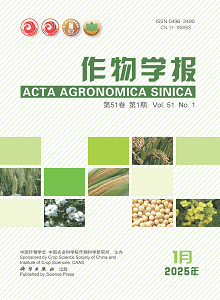Construction linkage maps and identification of quantitative trait loci associated with important agronomic traits in purple-fleshed sweetpotato
引用次数: 0
Abstract
: Ideal agronomic traits are the important objectives in sweetpotato breeding, but the breeding methods are still lacking. We constructed linkage maps using a mapping population of 274 individuals derived from a cross between the female parent Xuzishu 8 (a purple-fleshed cultivar with many branches, medium vine, and high yield) and the male parent Meiguohong (a white-fleshed cultivar with few branches, long vine, and medium yield) by simple sequence repeats (SSR) markers in this study. The female parent map contained 24 linkage groups, and covered 1325.8 cM with an average marker interval of 9.2 cM. The male parent map contained 21 linkage groups, and covered 1088.6 cM with an average marker interval of 8.2 cM. The maps could in-crease the density of existing genetic maps. Using the composite interval mapping, we analyzed five important agronomic traits, including branch number, vine diameter, longest vine length, petiole length, and internode length in sweetpotato, thus identified one QTL related to branch number explaining the phenotypic variance of 53.2%, one QTL related to internode diameter explaining the phenotypic variance of 16.7%, two QTLs related to longest vine length explaining the phenotypic variance of 9.5% and 13.7%, two QTLs related to petiole length explaining the phenotypic variance of 8.8% and 11.3%, and five QTLs related to inter-2148 node length explaining the phenotypic variance of 9.6%–28.1%. The QTLs can be used to develop molecular markers and assist the screening of plants with ideal agronomic traits at early seedling stage, thus improved the efficiency of field selection.紫肉甘薯重要农艺性状连锁图谱构建及相关数量性状位点鉴定
理想的农艺性状是甘薯选育的重要目标,但选育方法尚缺乏。本研究利用亲本“须子树8号”(多枝、中藤、高产的紫肉品种)与亲本“梅果红”(多枝、长藤、高产的白肉品种)杂交的274个亲本,通过SSR标记构建连锁图谱。母本亲本图谱包含24个连锁群,覆盖1325.8 cM,平均标记间隔为9.2 cM。父本图谱包含21个连锁群,覆盖面积为1088.6 cM,平均标记间隔为8.2 cM。这些图谱可以增加现有基因图谱的密度。利用复合区间定位分析了甘薯的分枝数、藤径、最长藤长、叶柄长和节间长5个重要农艺性状,鉴定出1个与分枝数相关的QTL解释表型变异为53.2%,1个与节间直径相关的QTL解释表型变异为16.7%,2个与最长藤长相关的QTL解释表型变异为9.5%和13.7%。2个叶柄长度相关的qtl解释表型方差为8.8%和11.3%,5个2148节间长度相关的qtl解释表型方差为9.6% ~ 28.1%。这些qtl可用于开发分子标记,帮助筛选苗期早期具有理想农艺性状的植株,从而提高田间选择效率。
本文章由计算机程序翻译,如有差异,请以英文原文为准。
求助全文
约1分钟内获得全文
求助全文
来源期刊

作物学报
Agricultural and Biological Sciences-Agronomy and Crop Science
CiteScore
1.70
自引率
0.00%
发文量
89
期刊介绍:
The major aims of AAS are to report the progresses in the disciplines of crop breeding, crop genetics, crop cultivation, crop physiology, ecology, biochemistry, germplasm resources, grain chemistry, grain storage and processing, bio-technology and biomathematics etc. mainly in China and abroad. AAS provides regular columns for Original papers, Reviews, and Research notes. The strict peer-review procedure guarantees the academic level and raises the reputation of the journal. The readership of AAS is for crop science researchers, students of agricultural colleges and universities, and persons with similar academic level.
 求助内容:
求助内容: 应助结果提醒方式:
应助结果提醒方式:


